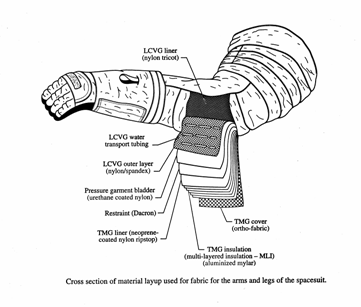
A space suit or spacesuit is a garment worn to keep a human alive in the harsh environment of outer space, vacuum and temperature extremes. Space suits are often worn inside spacecraft as a safety precaution in case of loss of cabin pressure, and are necessary for extravehicular activity (EVA), work done outside spacecraft. Space suits have been worn for such work in Earth orbit, on the surface of the Moon, and en route back to Earth from the Moon. Modern space suits augment the basic pressure garment with a complex system of equipment and environmental systems designed to keep the wearer comfortable, and to minimize the effort required to bend the limbs, resisting a soft pressure garment's natural tendency to stiffen against the vacuum. A self-contained oxygen supply and environmental control system is frequently employed to allow complete freedom of movement, independent of the spacecraft.

BoPET is a polyester film made from stretched polyethylene terephthalate (PET) and is used for its high tensile strength, chemical and dimensional stability, transparency, reflectivity, gas and aroma barrier properties, and electrical insulation. A variety of companies manufacture boPET and other polyester films under different brand names. In the UK and US, the best-known trade names are Mylar, Melinex, Lumirror and Hostaphan.

A micrometeoroid is a tiny meteoroid: a small particle of rock in space, usually weighing less than a gram. A micrometeorite is such a particle that survives passage through Earth's atmosphere and reaches Earth's surface.

The Extravehicular Mobility Unit (EMU) is an independent anthropomorphic spacesuit that provides environmental protection, mobility, life support, and communications for astronauts performing extravehicular activity (EVA) in Earth orbit. Introduced in 1981, it is a two-piece semi-rigid suit, and is currently one of two types of EVA spacesuits used by crew members on the International Space Station (ISS), the other being the Russian Orlan space suit. It was used by NASA's Space Shuttle astronauts prior to the end of the Shuttle program in 2011.
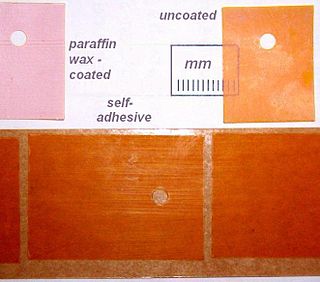
Kapton is a polyimide film used in flexible printed circuits and space blankets, which are used on spacecraft, satellites, and various space instruments. Invented by the DuPont Corporation in the 1960s, Kapton remains stable across a wide range of temperatures, from 4 to 673 K. Kapton is used in electronics manufacturing, space applications, with x-ray equipment, and in 3D printing applications. Its favorable thermal properties and outgassing characteristics result in its regular use in cryogenic applications and in situations where high vacuum environments are experienced.

Nomex is a flame-resistant meta-aramid material developed in the early 1960s by DuPont and first marketed in 1967.

The Whipple shield or Whipple bumper, invented by Fred Whipple, is a type of spaced armor shielding to protect crewed and uncrewed spacecraft from hypervelocity impact / collisions with micrometeoroids and orbital debris whose velocities generally range between 3 and 18 kilometres per second. According to NASA, the Whipple shield is designed to withstand collisions with debris up to 1 cm, which helps to mitigate the Kessler syndrome.

ILC Dover, LP is a special engineering development and manufacturing company, globally headquartered in Frederica, Delaware. ILC Dover specializes in the use of high-performance flexible materials, serving the aerospace, personal protection, and pharmaceutical industries.

The Apollo/Skylab space suit is a class of space suits used in Apollo and Skylab missions. The names for both the Apollo and Skylab space suits were Extravehicular Mobility Unit (EMU). The Apollo EMUs consisted of a Pressure Suit Assembly (PSA) aka "suit" and a Portable Life Support System (PLSS) that was more commonly called the "backpack". The A7L was the PSA model used on the Apollo 7 through 14 missions.

Sailcloth is cloth used to make sails. It can be made of a variety of materials, including natural fibers such as flax, hemp, or cotton in various forms of sail canvas, and synthetic fibers such as nylon, polyester, aramids, and carbon fibers in various woven, spun, and molded textiles.
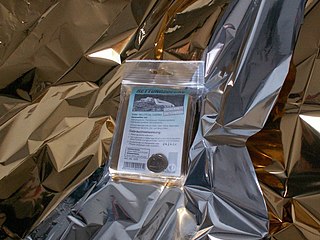
A space blanket is an especially low-weight, low-bulk blanket made of heat-reflective, thin, plastic sheeting. They are used on the exterior surfaces of spacecraft for thermal control, as well as by people. Their design reduces the heat loss in a person's body, which would otherwise occur due to thermal radiation, water evaporation, or convection. Their low weight and compact size before unfurling make them ideal when space or weight are at a premium. They may be included in first aid kits and with camping equipment. Lost campers and hikers have an additional possible benefit: the shiny surface flashes in the sun, allowing its use as an improvised distress beacon for searchers and as a method of signalling over long distances to other people.

The Apollo Telescope Mount, or ATM, was a crewed solar observatory that was a part of Skylab, the first American space station. It could observe the Sun in wavelengths ranging from soft X-rays, ultra-violet, and visible light.

A liquid cooling garment (LCG) is a form-fitting garment that is used to remove body heat from the wearer in environments where evaporative cooling from sweating and open-air convection cooling does not work or is insufficient, or the wearer has a biological problem that hinders self-regulation of body temperature.

Beta cloth is a type of fireproof silica fiber cloth used in the manufacture of Apollo/Skylab A7L space suits, the Apollo Thermal Micrometeoroid Garment, the McDivitt Purse, and in other specialized applications.
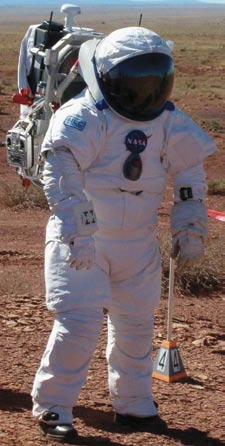
The I-Suit is a spacesuit model constructed by ILC Dover. The suit began as an EVA mobility demonstrator, developed to meet a contract awarded by NASA to ILC in 1997 for an all-soft suit.
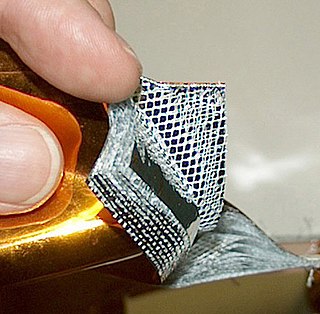
Multi-layer insulation (MLI) is thermal insulation composed of multiple layers of thin sheets and is often used on spacecraft and cryogenics. Also referred to as superinsulation, MLI is one of the main items of the spacecraft thermal design, primarily intended to reduce heat loss by thermal radiation. In its basic form, it does not appreciably insulate against other thermal losses such as heat conduction or convection. It is therefore commonly used on satellites and other applications in vacuum where conduction and convection are much less significant and radiation dominates. MLI gives many satellites and other space probes the appearance of being covered with gold foil which is the effect of the amber-coloured Kapton layer deposited over the silver Aluminized mylar.
Peter K. Homer of Southwest Harbor, Maine, won $200,000 from NASA for his entry in the Astronaut Glove Challenge. The competition was held on Thursday, May 3, 2007, with a total of five teams competing, and was one of NASA's seven Centennial Challenges. The gloves were rated on strength, flexibility and comfort. Homer's glove design performed better overall than the competition and NASA hopes it will help improve future astronaut gloves. He was unemployed at the time of his victory.

The Constellation Space Suit was a planned full pressure suit system that would have served as an intra-vehicular activity (IVA) and extra-vehicular activity (EVA) garment for the proposed Project Constellation flights. The design of the suit was announced by NASA on June 11, 2008, and it was to be manufactured by Houston, Texas-based Oceaneering International, the 4th company after the David Clark Company, Hamilton Sundstrand, and ILC Dover to produce life-support hardware, as a prime contractor, for in-flight space use.

In spacecraft design, the function of the thermal control system (TCS) is to keep all the spacecraft's component systems within acceptable temperature ranges during all mission phases. It must cope with the external environment, which can vary in a wide range as the spacecraft is exposed to the extreme coldness found in the shadows of deep space or to the intense heat found in the unfiltered direct sunlight of outer space. A TCS must also moderate the internal heat generated by the operation of the spacecraft it serves. A TCS can eject heat passively through the simple and natural infrared radiation of the spacecraft itself, or actively through an externally mounted infrared radiation coil.
